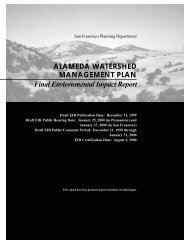Feasibility of Fish Passage at Alameda Creek Diversion Dam
Feasibility of Fish Passage at Alameda Creek Diversion Dam
Feasibility of Fish Passage at Alameda Creek Diversion Dam
Create successful ePaper yourself
Turn your PDF publications into a flip-book with our unique Google optimized e-Paper software.
<strong>Feasibility</strong> <strong>of</strong> <strong>Fish</strong> <strong>Passage</strong> <strong>at</strong> <strong>Alameda</strong> <strong>Creek</strong> <strong>Diversion</strong> <strong>Dam</strong>■■Screened <strong>Diversion</strong> with Schedule B Bypass Flows represents the estim<strong>at</strong>ed amount <strong>of</strong> w<strong>at</strong>er th<strong>at</strong>could have been diverted under simul<strong>at</strong>ed flows if bypass flows consistent with the SFPUCproposednormal w<strong>at</strong>er year instream flow schedule were bypassed downstream <strong>at</strong> ACDD, whileother flows up to 370 cfs were diverted during the November-through-April time period.Lost W<strong>at</strong>er <strong>Diversion</strong> Opportunity due to Screening compares the two different diversionscenarios (i.e., unscreened and screened) and quantifies the volume <strong>of</strong> w<strong>at</strong>er th<strong>at</strong> wouldpotentially not be diverted after screen implement<strong>at</strong>ion. Consistent with the order-<strong>of</strong>-magnitudecost estim<strong>at</strong>ing in this conceptual feasibility study, the SFPUC-proposed “normal w<strong>at</strong>er year”instream flow schedule (Schedule B) was used in this diversion comparison scenario.The estim<strong>at</strong>es depicted in Table 5-2 indic<strong>at</strong>e th<strong>at</strong> on average, use <strong>of</strong> screens results in an annualdiversion reduction <strong>of</strong> approxim<strong>at</strong>ely 1,510 acre-feet <strong>of</strong> w<strong>at</strong>er th<strong>at</strong> could have been diverted in anunscreened diversion condition. Annual reductions in diversion for both a wet and a dry w<strong>at</strong>er year areillustr<strong>at</strong>ed in Figure 5-2. For the purposes <strong>of</strong> this analysis, the average annual diversion reduction <strong>of</strong>approxim<strong>at</strong>ely 1,510 acre-feet <strong>of</strong> w<strong>at</strong>er was used to estim<strong>at</strong>e the annual diversion reduction due toscreening facility oper<strong>at</strong>ion. An estim<strong>at</strong>ed 2016 w<strong>at</strong>er r<strong>at</strong>e <strong>of</strong> $1,500 per acre-foot 11 was used in thisanalysis because it accounts for the time differential <strong>of</strong> up to several years between this estim<strong>at</strong>e and theactual construction and oper<strong>at</strong>ion <strong>of</strong> a potential fish ladder. Therefore, the annual lost diversionopportunity cost due to reduced diversion capacity with screening is approxim<strong>at</strong>ely $2,265,000. Thisw<strong>at</strong>er cost is added to the annualized screen component cost in Section 5.3.5.2.2 FISH SCREEN BYPASS FLOWS<strong>Fish</strong> screening would require bypass flows <strong>at</strong> the downstream end <strong>of</strong> the screens, to maintain sweepingvelocity and prevent fish and small debris from being impinged on the screens, and to provide safedownstream passage for fish (NMFS, 2008a). The volume <strong>of</strong> w<strong>at</strong>er available for diversion toCalaveras Reservoir would be reduced due to this requirement.For purposes <strong>of</strong> cost estim<strong>at</strong>ion it is assumed th<strong>at</strong> the fish screen bypass would require 5 cfs <strong>of</strong> flow,whenever flows sufficient are available, during the entire diversion period. The estim<strong>at</strong>ed annual w<strong>at</strong>ercost calcul<strong>at</strong>ion (Section 5.2) assumes th<strong>at</strong> the SFPUC-proposed normal w<strong>at</strong>er year instream flowschedule bypass flows (Section 2.3.2.2) will be used to oper<strong>at</strong>e the fish screen bypass when they areavailable. Because the SFPUC-proposed flows (dry, normal, and wet years) would always be sufficientfor oper<strong>at</strong>ion <strong>of</strong> a fish screen bypass (5 cfs minimum), it is assumed th<strong>at</strong> there is no additional annualw<strong>at</strong>er cost associ<strong>at</strong>ed with the oper<strong>at</strong>ion <strong>of</strong> the fish screen bypass alone. The entire w<strong>at</strong>er costassoci<strong>at</strong>ed with screening is due to the potential reduction in the maximum r<strong>at</strong>e <strong>of</strong> diversion withscreening, as described in Section 5.2.1.5.2.3 FISH LADDER OPERATION FLOWSOper<strong>at</strong>ion <strong>of</strong> a fish ladder <strong>at</strong> ACDD would require a prescribed set <strong>of</strong> minimum flows, whenavailable, to be maintained prior to any w<strong>at</strong>er diversion during certain months <strong>of</strong> the year when theladder would be in oper<strong>at</strong>ion, December through April (Table 4-1). Therefore, the volume <strong>of</strong> w<strong>at</strong>eravailable for diversion to Calaveras Reservoir would also likely be reduced if a fishway wasimplemented. The degree to which SFPUC-proposed instream flows (Section 2.3.2.2) would besufficient to oper<strong>at</strong>e a fishway, and the cost <strong>of</strong> the w<strong>at</strong>er in excess <strong>of</strong> the proposed flows th<strong>at</strong> wouldbe required for th<strong>at</strong> purpose is addressed in this section.11Cost <strong>of</strong> w<strong>at</strong>er cited may be a minimum cost <strong>of</strong> replacement w<strong>at</strong>er (w<strong>at</strong>er lost from storage) as it will depend on whereand how SFPUC is able to replace the w<strong>at</strong>er. For example, recycled w<strong>at</strong>er development in San Francisco is estim<strong>at</strong>edto cost approxim<strong>at</strong>ely $3,900 per acre-foot. Thus, the actual cost <strong>of</strong> replacement w<strong>at</strong>er will depend on replacementsources available <strong>at</strong> the time replacement w<strong>at</strong>er is needed.ACDD <strong>Passage</strong> June 2009 Page 5-6








